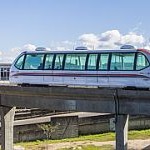Brazil Installs 100% Composite Air Train in Preparation for World Cup
The city of Porto Alegre, Brazil has inaugurated the country’s first automated, air-propulsion passenger transport system, with a body built entirely from composites. The elevated rail line provides quick, easy-access for commuters and visitors between the Metro Airport Tube Station and Terminal 1 at the International Salgado Filho Airport. The city estimates that the 1km line, which takes about 90 seconds with maximum speed of 65 km/h, will transport as many as 10,000 passengers per day.Based on a unique, patented Brazilian technology, the Aeromovel uses propulsion from air pressure over the rails to move the lightweight vehicle forward. The air fans are powered by electricity and offer a low-energy-cost, zero-emission alternative for public transportation. Even noise pollution is reduced with the soundproofed fans. Barracuda Advanced Composites (Barracuda) developed the Finite Element Analysis for the train and verified the stress and strain on the body. A long-time DIAB distributor, BAC specified the composite sandwich body construction including DIAB’s IPN foam, Divinycell Matrix 7-7, using an infusion system with self-extinguishing resin. According to Barracuda, “Composite sandwich construction makes the train light and have high resistance to transport a large number of passengers safely.” The company also highlights the environmental benefits: “Both the propulsion system and the low-emission manufacturing process contribute to a better environment. The vacuum infusion process moves the resin within a sealed plastic bag, avoiding emission of toxic gases that pollute the environment.”As demand continues to increase for lighter vehicles that help reduce greenhouse gas emissions, Porto Alegre’s Aeromovel is only the beginning. Jorge Nasseh, CEO for Barracuda, shares that the company already has several more trains on the drawing board featuring DIAB sandwich composite construction.
Fonte: Observatorioplastico
Fonte Foto: Photo provided by Barracuda Composites












